View in other NatureServe Network Field Guides
NatureServe
Montana
Utah
Wyoming
Idaho
Wisconsin
British Columbia
South Carolina
Yukon
California
New York
Gray Hairstreak - Strymon melinus
Native Species
Global Rank:
G5
State Rank:
S5
Agency Status
USFWS:
USFS:
BLM:
External Links
General Description
[From Ferris and Brown 1981; Scott 1986; Opler and Wright 1999; Glassberg 2001; Pyle 2002] Forewing 1.2-1.5 cm. Two-tailed, the lower one longer. Male abdomen pale orange, female abdomen gray. Uppersurface gray with orange spot near tail; undersurface paler gray, hindwing postmedian line often edged inward with orange and outward with white, postmedian line usually relatively straight, orange hindwing marginal spot flat across inward edge and almost reaching postmedian line.
Phenology
Many flights; spring to fall (Scott 1986). Flies almost all year in the south but mainly March to October elsewhere, May to August at higher elevations and latitudes (Glassberg 2001). Mid-April to October in Colorado (Scott and Scott 1978), late March to mid-October in Oregon and Washington (Pyle 2002; Warren 2005), late April to late August in British Columbia (Guppy and Shepard 2001).
Diagnostic Characteristics
Best determined by uppersurface gray with orange spot near tail, undersurface hindwing postmedian line often edged inward with orange and outward with white, orange hindwing marginal spot flat across inward edge and almost reaching postmedian line.
Species Range
Montana Range
Range Descriptions
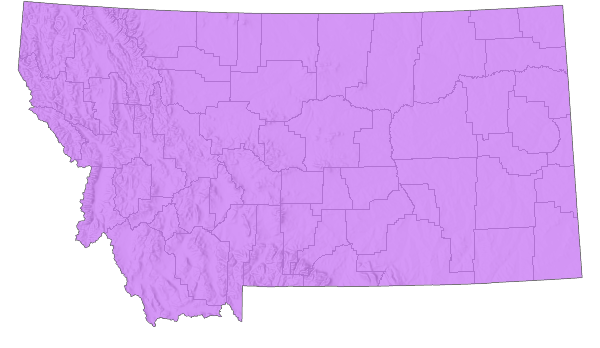
 Native
Native
Range Comments
Across southern Canada south through US and Mexico to northern South America (Scott 1986; Opler and Wright 1999; Glassberg 2001); usually below 2133 m elevation in Colorado but to at least 2926 m (Brown 1957; Scott and Scott 1978; Ferris and Brown 1981), sea level to 2438 m elevation in Oregon (Warren 2005). In Montana, reported throughout the state (Kohler 1980; Stanford and Opler 1993). Common to abundant in Texas and southern California, rare to uncommon elsewhere (Glassberg 2001).
Observations in Montana Natural Heritage Program Database
Number of Observations: 19
(Click on the following maps and charts to see full sized version)
Map Help and Descriptions
Relative Density
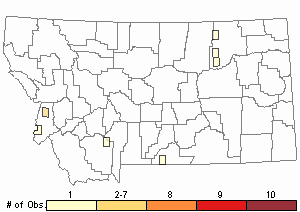
Recency

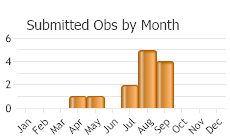
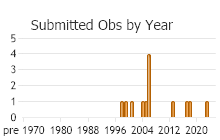
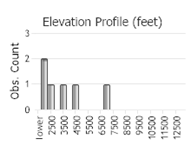 (Observations spanning multiple months or years are excluded from time charts)
(Observations spanning multiple months or years are excluded from time charts)
Migration
Non-migratory.
Habitat
Open weedy areas, grasslands, sagebrush steppe, montane meadows, river basins, agricultural areas (Opler and Wright 1999; Glassberg 2001; Pyle 2002). Habitat in Montana not described but probably similar.
Food Habits
Larval food plants are very diverse, and include Amorpha, Amphicarpa, Asclepias, Astragalus, Callirhoe, Carya, Cassia, Citrus, Comptonia, Crataegus, Croton, Cynoglossum, Desmodium, Diospyros, Echites, Eremocarpus, Eriobotrya, Eriogonum, Fragaria, Glycyrrhiza, Gossypium, Hibiscus, Humulus, Hypericum, Hyptis, Indigofera, Lamium, Lantana, Lespedeza, Lotus, Lupinus, Malus, Malva, Medicago, Melilotus, Mentzelia, Neolloydia, Nolina, Phaseolus, Pinus, Pisum, Polygonum, Porlieria, Quercus, Rhamnus, Rhododendron, Rosa, Rubus, Rumex, Sabal, Salsola, Salvia, Sedum, Sesbania, Sida, Sidalcea, Sphaeralcea, Tecoma, Trifolium, Verbascum, Vicia, Vigna, and Zea (Scott 1986, 1992, 2006; Guppy and Shepard 2001; Warren 2005; James and Nunnallee 2011). Adults feed on flower nectar (including Abronia, Achillea, Aesculus, Agastache, Allium, Apocynum, Arctium, Asclepias, Astragalus, Baccharis, Berberis, Berteroa, Bidens, Boltonia, Buddleia, Carduus, Ceanothus, Centaurea, Cephalanthus, Chrysanthemum, Chrysothamnus, Cirsium, Clematis, Comandra, Conyza, Coreopsis, Croton, Dalea, Echinacea, Erigeron, Eriogonum, Eryngium, Eupatorium, Euphorbia, Geranium, Glycrrhiza, Gutierrezia, Helianthus, Hesperis, Heterotheca, Lesquerella, Liatris, Linaria, Marrubium, Medicago, Melilotus, Mentha, Oxytropis, Phacelia, Phlox, Plantago, Polygonum, Prunus, Psoralea, Pycnanthemum, Ratibida, Rhus, Rudbeckia, Salix, Senecio, Solidago, Sphaeralcea, Symphyotrichum, Taraxacum, Thelesperma, Trifolium, Verbascum, Verbena, Verbesina, Viguiera, Zinia) and mud (Tooker et al. 2002; Scott 2014).
Reproductive Characteristics
Females lay eggs singly on host plant inflorescences, flower buds, fruits, small leaves near flowers, seeds (Scott 1986, 1992, 2006). Eggs hatch in captivity in about 3 days, larvae develop to L4 instars in about 24 days post egg-hatch (depending on temperature), pupate in another 3-4 days, adults eclose (emerge from pupae) in about 7-10 days after pupation. Larvae feed on flowers and frots, build no nest, associate with ants, pupate in sheltered location like curled leaf, overwinter as pupa (Scott 1979, 1986; James and Nunnallee 2011). Males perch on small hilltop trees or shrubs, usually late morning through afternoon, waiting for passing females (Scott 1975b, 1982, 1986).
Stewardship Responsibility
References
- Literature Cited AboveLegend:
 View Online Publication
View Online Publication Brown, F.M. 1957. Colorado Butterflies. Proceedings; Numbers Three through Seven. Denver Museum of Natural History, Denver, Co.
Brown, F.M. 1957. Colorado Butterflies. Proceedings; Numbers Three through Seven. Denver Museum of Natural History, Denver, Co. Ferris, C.D. and F.M. Brown (eds). 1981. Butterflies of the Rocky Mountains. Univ. of Oklahoma Press. Norman. 442 pp.
Ferris, C.D. and F.M. Brown (eds). 1981. Butterflies of the Rocky Mountains. Univ. of Oklahoma Press. Norman. 442 pp. Glassberg, J. 2001. Butterflies through Binoculars: A Field Guide to the Butterflies of Western North America. Oxford University Press.
Glassberg, J. 2001. Butterflies through Binoculars: A Field Guide to the Butterflies of Western North America. Oxford University Press. Guppy, C.S. and J.H. Shepard. 2001. Butterflies of British Columbia: including western Alberta, southern Yukon, the Alaska Panhandle, Washington, northern Oregon, northern Idaho, northwestern Montana. UBC Press (Vancouver, BC) and Royal British Columbia Museum (Victoria, BC). 414 pp.
Guppy, C.S. and J.H. Shepard. 2001. Butterflies of British Columbia: including western Alberta, southern Yukon, the Alaska Panhandle, Washington, northern Oregon, northern Idaho, northwestern Montana. UBC Press (Vancouver, BC) and Royal British Columbia Museum (Victoria, BC). 414 pp. James, D.G. and D. Nunnallee. 2011. Life histories of Cascadia butterflies. Corvallis, OR: Oregon State University Press. 447 p.
James, D.G. and D. Nunnallee. 2011. Life histories of Cascadia butterflies. Corvallis, OR: Oregon State University Press. 447 p. Kohler, S. 1980. Checklist of Montana Butterflies (Rhopalocera). Journal of the Lepidopterists' Society 34(1): 1-19.
Kohler, S. 1980. Checklist of Montana Butterflies (Rhopalocera). Journal of the Lepidopterists' Society 34(1): 1-19. Opler, P.A. and A.B. Wright. 1999. A field guide to western butterflies. Second edition. Peterson Field Guides. Houghton Mifflin Company, Boston, Massachusetts. 540 pp.
Opler, P.A. and A.B. Wright. 1999. A field guide to western butterflies. Second edition. Peterson Field Guides. Houghton Mifflin Company, Boston, Massachusetts. 540 pp. Pyle, R.M. 2002. The butterflies of Cascadia: a field guide to all the species of Washington, Oregon, and surrounding territories. Seattle Audubon Society, Seattle, Washington. 420 pp.
Pyle, R.M. 2002. The butterflies of Cascadia: a field guide to all the species of Washington, Oregon, and surrounding territories. Seattle Audubon Society, Seattle, Washington. 420 pp. Scott, J.A. 1975b. Mate-locating behavior of western North American butterflies. Journal of Research on the Lepidoptera 14:1-40.
Scott, J.A. 1975b. Mate-locating behavior of western North American butterflies. Journal of Research on the Lepidoptera 14:1-40. Scott, J.A. 1979. Hibernal diapause of North American Papilionoidea and Hesperioidea. Journal of Research on the Lepidoptera 18(3): 171-200.
Scott, J.A. 1979. Hibernal diapause of North American Papilionoidea and Hesperioidea. Journal of Research on the Lepidoptera 18(3): 171-200. Scott, J.A. 1982. Mate-locating behavior of western North American butterflies. II. New observations and morphological adaptations. Journal of Research on the Lepidoptera 21(3): 177-187.
Scott, J.A. 1982. Mate-locating behavior of western North American butterflies. II. New observations and morphological adaptations. Journal of Research on the Lepidoptera 21(3): 177-187. Scott, J.A. 1986. The butterflies of North America: a natural history and field guide. Stanford University Press, Stanford, California.
Scott, J.A. 1986. The butterflies of North America: a natural history and field guide. Stanford University Press, Stanford, California. Scott, J.A. 1992. Hostplant records for butterflies and skippers (mostly from Colorado) 1959-1992, with new life histories and notes on oviposition, immatures, and ecology. Papilio new series #6. 185 p.
Scott, J.A. 1992. Hostplant records for butterflies and skippers (mostly from Colorado) 1959-1992, with new life histories and notes on oviposition, immatures, and ecology. Papilio new series #6. 185 p. Scott, J.A. 2006. Butterfly hostplant records, 1992-2005, with a treatise on the evolution of Erynnis, and a note on new terminology for mate-locating behavior. Papilio new series #14. 74 p.
Scott, J.A. 2006. Butterfly hostplant records, 1992-2005, with a treatise on the evolution of Erynnis, and a note on new terminology for mate-locating behavior. Papilio new series #14. 74 p. Scott, J.A. 2014. Lepidoptera of North America 13. Flower visitation by Colorado butterflies (40,615 records) with a review of the literature on pollination of Colorado plants and butterfly attraction (Lepidoptera: Hersperioidea and Papilionoidea). Contributions of the C.P. Gillette Museum of Arthopod Diversity. Fort Collins, CO: Colorado State University. 190 p.
Scott, J.A. 2014. Lepidoptera of North America 13. Flower visitation by Colorado butterflies (40,615 records) with a review of the literature on pollination of Colorado plants and butterfly attraction (Lepidoptera: Hersperioidea and Papilionoidea). Contributions of the C.P. Gillette Museum of Arthopod Diversity. Fort Collins, CO: Colorado State University. 190 p. Scott, J.A. and G.R. Scott. 1978. Ecology and distribution of the butterflies of southern central Colorado. Journal of Research on the Lepidoptera 17(2): 73-128.
Scott, J.A. and G.R. Scott. 1978. Ecology and distribution of the butterflies of southern central Colorado. Journal of Research on the Lepidoptera 17(2): 73-128. Stanford, R.E. and P.A. Opler. 1993. Atlas of western USA butterflies: including adjacent parts of Canada and Mexico. Unpubl. Report. Denver and Fort Collins, Colorado 275 pp.
Stanford, R.E. and P.A. Opler. 1993. Atlas of western USA butterflies: including adjacent parts of Canada and Mexico. Unpubl. Report. Denver and Fort Collins, Colorado 275 pp. Tooker, J.F., P.F. Reagel, and L.M. Hanks. 2002. Nectar sources of day-flying lepidoptera of central Illinois. Annals of the Entomological Society of America 95(1): 84-96.
Tooker, J.F., P.F. Reagel, and L.M. Hanks. 2002. Nectar sources of day-flying lepidoptera of central Illinois. Annals of the Entomological Society of America 95(1): 84-96. Warren, A.D. 2005. Lepidoptera of North America 6: Butterflies of Oregon, their taxonomy, distribution, and biology. Contributions of the C. P. Gillette Museum of Arthropod Diversity, Colorado State University. Fort Collins, Colorado. 406 pp.
Warren, A.D. 2005. Lepidoptera of North America 6: Butterflies of Oregon, their taxonomy, distribution, and biology. Contributions of the C. P. Gillette Museum of Arthropod Diversity, Colorado State University. Fort Collins, Colorado. 406 pp.
- Additional ReferencesLegend:
 View Online Publication
View Online Publication
Do you know of a citation we're missing? Allen, T.J., J.P. Brock, and J. Glassberg. 2005. Caterpillars in the field and garden: a field guide to the butterfly caterpillars of North America. Oxford University Press.
Allen, T.J., J.P. Brock, and J. Glassberg. 2005. Caterpillars in the field and garden: a field guide to the butterfly caterpillars of North America. Oxford University Press. Brock, J.P. and K. Kaufman. 2003. Kaufman Field Guide to Butterflies of North America. Houghton Mifflin Company, New York, NY 284 pp.
Brock, J.P. and K. Kaufman. 2003. Kaufman Field Guide to Butterflies of North America. Houghton Mifflin Company, New York, NY 284 pp. Forister, M.L., C.A. Halsch, C.C. Nice, J.A. Fordyce, T.E. Dilts, J.C. Oliver, K.L. Prudic, A.M. Shapiro, J.K. Wilson, J. Glassberg. 2021. Fewer butterflies seen by community scientists across the warming and drying landscapes of the American West. Science 371:1042-1045.
Forister, M.L., C.A. Halsch, C.C. Nice, J.A. Fordyce, T.E. Dilts, J.C. Oliver, K.L. Prudic, A.M. Shapiro, J.K. Wilson, J. Glassberg. 2021. Fewer butterflies seen by community scientists across the warming and drying landscapes of the American West. Science 371:1042-1045. Forister, M.L., E.M. Grames, C.A. Halsch, K.J. Burls, C.F. Carroll, K.L. Bell, J.P. Jahner, et al. 2023. Assessing risk for butterflies in the context of climate change, demographic uncertainty, and heterogeneous data sources. Ecological Monographs 93(3):e1584. https://doi.org/10.1002/ecm.1584
Forister, M.L., E.M. Grames, C.A. Halsch, K.J. Burls, C.F. Carroll, K.L. Bell, J.P. Jahner, et al. 2023. Assessing risk for butterflies in the context of climate change, demographic uncertainty, and heterogeneous data sources. Ecological Monographs 93(3):e1584. https://doi.org/10.1002/ecm.1584 Layberry, R.A., P.W. Hall, and J.D. LaFontaine. 1998. The Butterflies of Canada. University of Toronto Press. 280 pp. + color plates.
Layberry, R.A., P.W. Hall, and J.D. LaFontaine. 1998. The Butterflies of Canada. University of Toronto Press. 280 pp. + color plates. Sater, S. 2022. The insects of Sevenmile Creek, a pictorial guide to their diversity and ecology. Undergraduate Thesis. Helena, MT: Carroll College. 242 p.
Sater, S. 2022. The insects of Sevenmile Creek, a pictorial guide to their diversity and ecology. Undergraduate Thesis. Helena, MT: Carroll College. 242 p.
- Web Search Engines for Articles on "Gray Hairstreak"
- Additional Sources of Information Related to "Insects"





